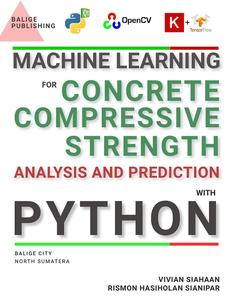MACHINE LEARNING FOR CONCRETE COMPRESSIVE STRENGTH ANALYSIS AND PREDICTION WITH PYTHON

Free Download MACHINE LEARNING FOR CONCRETE COMPRESSIVE STRENGTH ANALYSIS AND PREDICTION WITH PYTHON by Vivian Siahaan, Rismon Hasiholan Sianipar
English | May 14, 2022 | ISBN: N/A | ASIN: B0B1CP5QJ6 | 533 pages | MOBI | 18 Mb
Welcome to "Machine Learning for Concrete Compressive Strength Analysis and Prediction with Python." In this book, we will explore the fascinating field of applying machine learning techniques to analyze and predict the compressive strength of concrete.
First, we will dive into the dataset, which includes various features related to concrete mix proportions, age, and other influential factors. We will explore the dataset’s structure, dimensions, and feature types, ensuring that we have a solid understanding of the data we are working with. Then, we will focus on data exploration and visualization. We will utilize histograms, box Descriptions, and scatter Descriptions to gain insights into the distribution of features and their relationships with the target variable, enabling us to uncover valuable patterns and trends within the dataset. Before delving into machine learning algorithms, we must preprocess the data. We will handle missing values, encode categorical variables, and scale numerical features to ensure that our data is in the optimal format for training and testing our models.
Then, we will explore popular algorithms such as Linear Regression, Decision Trees, Random Forests, Support Vector, Naïve Bayes, K-Nearest Neighbors, Adaboost, Gradient Boosting, Extreme Gradient Boosting, Light Gradient Boosting, Catboost, and Multi-Layer Perceptron regression algorithms and use them to predict the concrete compressive strength accurately. We will evaluate and compare the performance of these models using regression metrics such as Mean Squared Error (MSE), Root Mean Squared Error (RMSE), Mean Absolute Error (MAE), and R-squared (R2) score.
Then, we will explore the exciting world of unsupervised learning by applying K-means clustering. This technique allows us to identify patterns within the data and group similar instances together, leading to valuable insights into the characteristics of different concrete samples. To determine the optimal number of clusters within the data, we will introduce evaluation methods such as the elbow method. We will then visualize the clusters using scatter Descriptions or other appropriate techniques, allowing us to gain a deeper understanding of their distribution and distinct groups.
DONWLOAD FROM RAPIDGATOR
3ujqm.rar.html
DOWNLOAD FROM NITROFLARE
3ujqm.rar
DONWLOAD FROM UPLOADGIG
3ujqm.rar
Fikper
3ujqm.rar.html